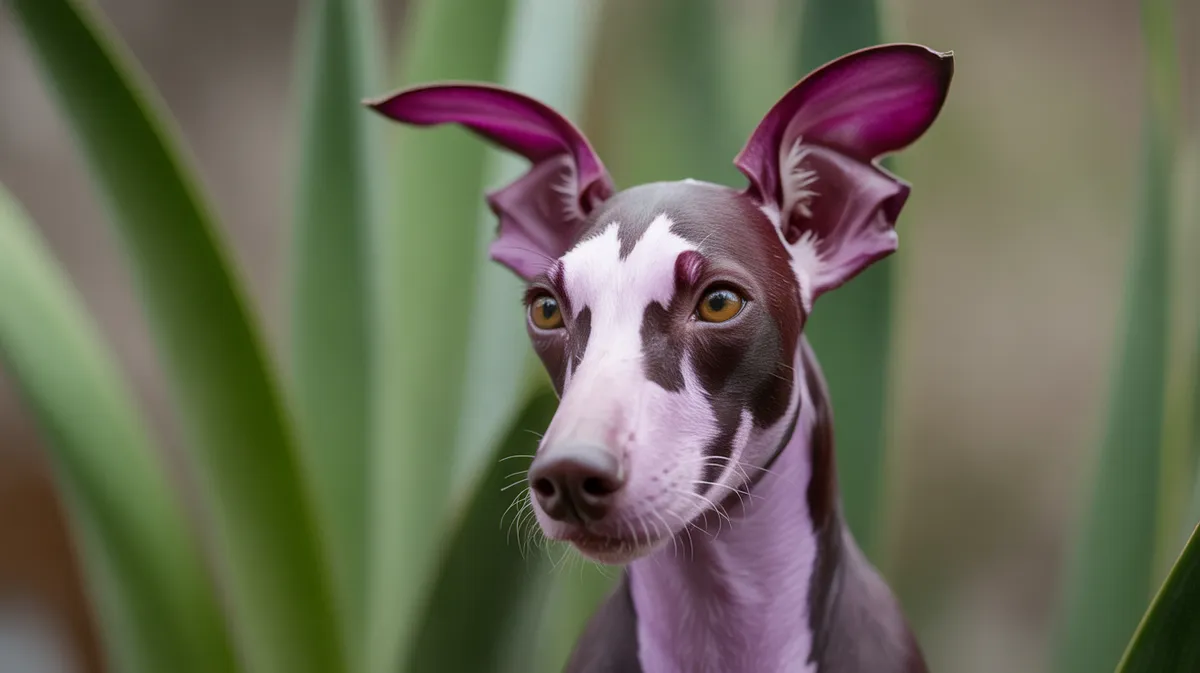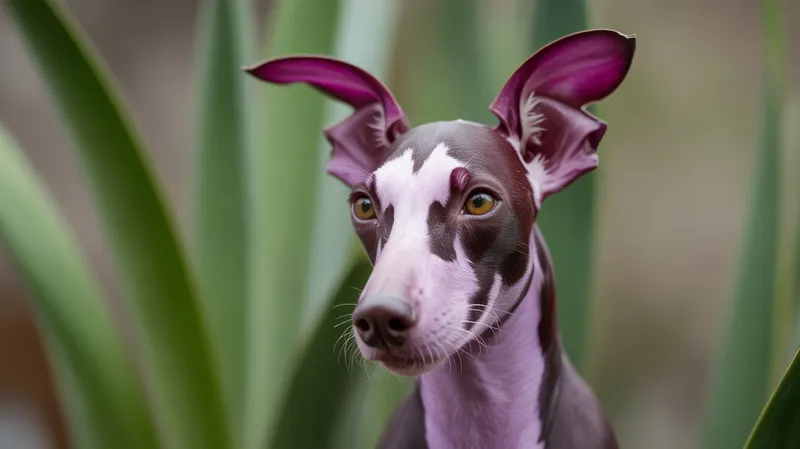
Peruvian Inca Orchid
Canis lupus familiaris

Meet the Peruvian Inca Orchid
The Peruvian Inca Orchid is an ancient and elegant breed of dog native to Peru, distinguished by its nearly hairless body and graceful physique. Known for its affectionate and loyal temperament, this breed has been cherished as a companion since pre-Incan times, often depicted in ancient pottery and artifacts. The breed comes in both hairless and coated varieties, with the hairless type being more common. Its skin can be a range of colors and often requires special care to protect from sunburn and cold. The Peruvian Inca Orchid is intelligent, agile, and makes an excellent companion for active families.
Classification
Mammal
Habitat
Domestic, originally from arid and temperate regions of Peru
Diet
Omnivore
Lifespan
12-14 years
Conservation
Least Concern
Weight
8-25 kg (18-55 lbs)
📖Fascinating Facts
Unique Name
The breed’s name comes from their association with the Inca civilization and the beautiful orchids found in Peru.
Ancient Lineage
Artifacts depicting Peruvian Inca Orchids date back to 750 AD, making them one of the oldest known dog breeds in South America.
Sensitive Skin
Due to their lack of fur, hairless Peruvian Inca Orchids require sunscreen or protective clothing to avoid sunburn.
📋Detailed Description
The Peruvian Inca Orchid (Perro Sin Pelo del Perú) is a medium-sized, sighthound-type breed notable for its elegant, slender build and predominantly hairless body, though a coated variety also exists. Adults typically stand 25–65 cm (10–26 in) at the shoulder and weigh 4–25 kg (9–55 lbs), with three recognized size categories: small, medium, and large. The skin, which can be mottled or solid and ranges from pink to black, is smooth, warm to the touch, and often features sparse tufts of hair on the head, feet, and tail. The breed’s almond-shaped eyes, erect or semi-erect ears, and long, tapering limbs contribute to its graceful appearance and agility. Peruvian Inca Orchids are known for their keen senses, particularly sight and hearing, which historically aided them in hunting small game. Socially, they are affectionate and form strong bonds with their human families, displaying loyalty and a gentle demeanor, though they can be reserved with strangers. Their intelligence and sensitivity make them responsive to training but also prone to stress if not properly socialized. Reproduction is typical of domestic dogs, but the hairless gene is dominant and homozygosity is lethal, so all hairless individuals are heterozygous and breeding must involve at least one coated parent to maintain genetic health. The breed is adapted to Peru’s arid and temperate environments, with skin requiring protection from sun and cold. Their unique physiology, including a higher skin temperature and reduced odor, is a result of centuries of adaptation and selective breeding.
💡 Did you know?
The Peruvian Inca Orchid is considered so special in its homeland that it was officially declared part of Peru's cultural heritage in 2001.
🔬Research & Sources
Wikipedia Summary
The Peruvian Hairless Dog or Perro Sin Pelo del Perú is a Peruvian breed of hairless dog. It is the only living breed of dog indigenous to Peru.
Last Modified: 5/25/2025
🎭Behavior & Social Structure
Peruvian Inca Orchids are diurnal and highly alert, often acting as vigilant watchdogs due to their acute senses. They are generally quiet indoors but can be energetic and playful during exercise, requiring regular physical and mental stimulation. Their sighthound heritage is evident in their propensity to chase moving objects, and they may display strong prey drive toward small animals. Socially, they are affectionate with family members and can be deeply loyal, sometimes forming a primary attachment to one person. They are sensitive to harsh discipline and respond best to positive reinforcement. While reserved or cautious with strangers, proper socialization from an early age can mitigate shyness. In group settings, they may establish a loose hierarchy but typically coexist peacefully with other dogs. Feeding behavior is omnivorous, though they thrive on high-quality, protein-rich diets. Grooming needs are minimal for hairless individuals, but skin care is essential to prevent dryness, sunburn, or injury.
👶Reproduction & Life Cycle
The breed exhibits typical canine reproductive behavior, with females coming into estrus approximately twice a year. Mating is usually preceded by courtship behaviors such as sniffing, licking, and play. The gestation period averages 58–63 days. Litter sizes range from 3 to 8 puppies, with both hairless and coated pups possible due to the breed’s genetics. The hairless gene (Hr) is dominant but homozygous lethal, so all hairless dogs are heterozygous (Hr/hr), and breeding two hairless individuals can result in non-viable embryos. Responsible breeders often mate a hairless to a coated dog to ensure healthy litters. Parental care is typical of domestic dogs, with the dam providing warmth, grooming, and nourishment. Puppies require careful skin management from birth, especially the hairless variety, to prevent dehydration and injury.
🛡️Adaptations & Survival
The Peruvian Inca Orchid’s most distinctive adaptation is its hairlessness, which reduces parasite load and helps dissipate heat in Peru’s arid climate. The breed’s skin is thicker and more elastic than that of coated dogs, with increased sebaceous gland activity to maintain moisture. Their higher skin temperature is a thermoregulatory adaptation, and they often seek out warmth or cover to compensate for heat loss. The breed’s long legs and streamlined body are adaptations for speed and agility, aiding in pursuit of prey. Their acute vision and hearing are evolutionary specializations for detecting movement and sound in open landscapes. Behavioral adaptations include a strong bond with humans, likely reinforced by centuries of domestication and selective breeding for companionship.
📚Research Sources
🎨Cultural Significance
The Peruvian Inca Orchid holds deep cultural significance in Peru, with archaeological evidence of the breed dating back to pre-Incan civilizations such as the Moche, Chimu, and Inca. The dogs are frequently depicted in ancient ceramics and textiles, often associated with nobility and spiritual symbolism. They were believed to possess healing properties, particularly for rheumatism and respiratory ailments, due to their warm skin. The breed is recognized as a national patrimony of Peru and was declared a cultural heritage breed in 2001. Today, they are celebrated as living symbols of Peru’s indigenous heritage and are featured in festivals, art, and tourism.
🔬Recent Research & Discoveries
Recent genetic studies have confirmed the ancient origins of the Peruvian Inca Orchid, revealing close relationships with other indigenous South American breeds and evidence of a unique mutation responsible for hairlessness (FOXI3 gene). Ongoing research focuses on the breed’s genetic diversity, health issues related to hairlessness, and optimal breeding strategies to avoid genetic disorders. Studies on their skin microbiome and immune function are providing insights into adaptations to hairlessness. Conservation programs in Peru, supported by national and international kennel clubs, are working to document pedigrees and promote breed standards.
🎥Wildlife Videos

THE PERUVIAN HAIRLESS DOG - STRANGE OR CUTE?
Anneka meets one of the rarest dogs on the planet - The Peruvian Hairless or the Inca Orchid Flower Dog of Peru. Not the same ...
Animal Watch

Pet4you.gr: Dogs Peruvian Inca Orchid
Pet4you.gr: Dogs Peruvian Inca Orchid.
Stathis Varveris

Peruvian Inca Orchid - Dogs 101
Peruvian Inca Orchids Are Intelligent,Protective, And Affectionate http://www.choosing-a-dog-made-easy.com/
Choosing A Dog Made Easy

Discover the Surprising Truths about Peruvian Inca Orchid Dog
From the strange history of the Peruvian Inca Orchid dog to their unusual ecology, we'll explore some of the surprising truths about ...
Facts about your pooch bet you didn` know

Xoloitzcuintli vs. Peruvian Inca Orchid: Ancient Breeds Unveiled!
Discover the fascinating world of two ancient and rare dog breeds: the Xoloitzcuintli (Mexican Hairless Dog) and the Peruvian Inca ...
CanineCompare

Peruvian Inca Orchid Dogs 101: Amazing Dog Facts In 60 Seconds 🐶🕒
The Peruvian Inca Orchid (PIO) is a unique hairless breed known for its elegance and affectionate nature! ❤️ Originating from ...
Paws & Claws
🌍Habitat Information
The Peruvian Inca Orchid typically inhabits Domestic, originally from arid and temperate regions of Peru environments. Peruvian Inca Orchids have adapted to their environments with specialized features and behaviors.
Primary Habitat:
Domestic, originally from arid and temperate regions of Peru
More detailed habitat information will be available soon.
🛡️Conservation Status
The Peruvian Inca Orchid is currently classified as Least Concern. Conservation efforts are crucial for preserving this species for future generations.
Common Threats:
- 🏠Habitat loss and fragmentation
- 🌡️Climate change impacts
- 🎯Hunting and poaching
- 🏭Human-wildlife conflict
⚠️Threats & Conservation Challenges
While the Peruvian Inca Orchid is not currently at risk of extinction, it faces challenges from genetic bottlenecks, irresponsible breeding, and loss of traditional roles in Peruvian society. The popularity of imported breeds and urbanization have reduced its prevalence in some regions. Skin problems, including sunburn, dermatitis, and injury, are common health concerns, especially in climates outside their native range. The breed’s genetic health is also threatened by the lethal nature of the homozygous hairless gene, necessitating careful breeding practices. Conservation efforts focus on maintaining genetic diversity and promoting responsible ownership.
🔬Scientific Classification
Scientific Name
Canis lupus familiaris
Classification Hierarchy
🔍 About Taxonomic Classification
Taxonomic classification is a hierarchical system used by scientists to classify and organize living organisms based on shared characteristics and evolutionary relationships.
The system moves from broad categories (Kingdom) to increasingly specific ones, with each animal's scientific name typically consisting of its Genus and species.
📝Community Notes
Share your observations and insights about the Peruvian Inca Orchid with our community of wildlife enthusiasts.
Join Our Community
Sign in to share your observations and connect with fellow wildlife enthusiasts.
Sign In to ContributeNo community notes yet
Be the first to share your observations about the Peruvian Inca Orchid!
Explore Peruvian Inca Orchid
Select a tab above to learn more about this amazing animal.
📸Photo Gallery
No photos available for this animal yet.
🌟Discover More Wildlife
Continue your journey of discovery with more fascinating animals from our database
